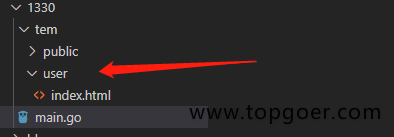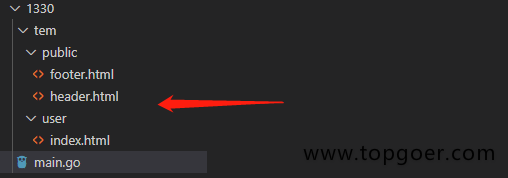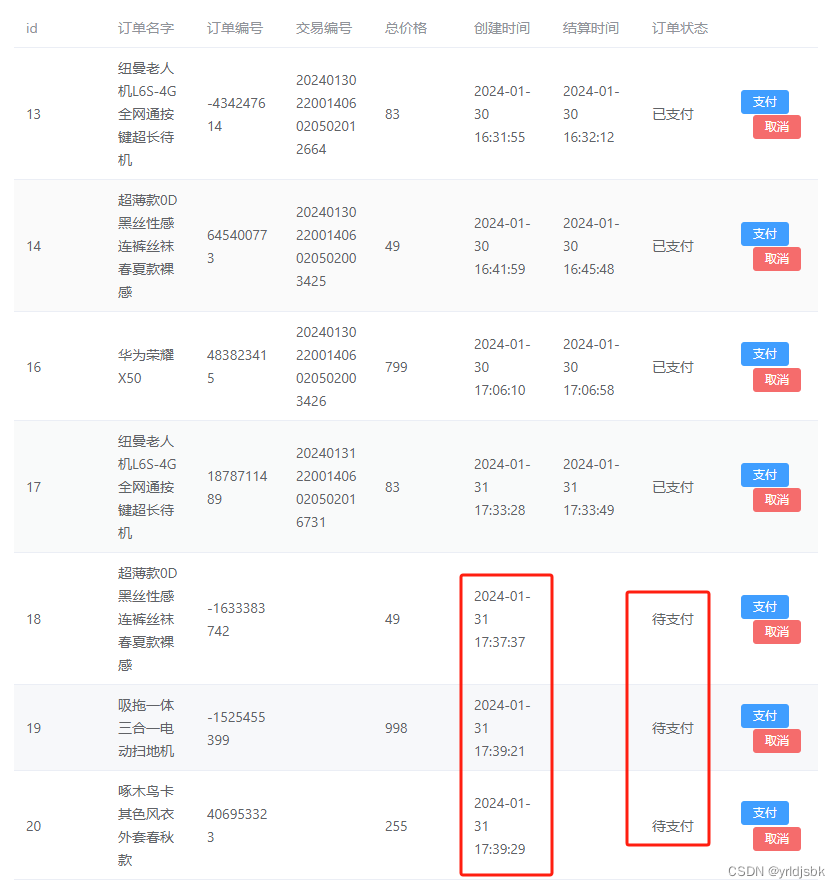本文介绍: 【代码】gin渲染篇。
1. 各种数据格式的响应
- json、结构体、XML、YAML类似于java的properties、ProtoBuf
package main
import (
"github.com/gin-gonic/gin"
"github.com/gin-gonic/gin/testdata/protoexample"
)
// 多种响应方式
func main() {
// 1.创建路由
// 默认使用了2个中间件Logger(), Recovery()
r := gin.Default()
// 1.json
r.GET("/someJSON", func(c *gin.Context) {
c.JSON(200, gin.H{"message": "someJSON", "status": 200})
})
// 2. 结构体响应
r.GET("/someStruct", func(c *gin.Context) {
var msg struct {
Name string
Message string
Number int
}
msg.Name = "root"
msg.Message = "message"
msg.Number = 123
c.JSON(200, msg)
})
// 3.XML
r.GET("/someXML", func(c *gin.Context) {
c.XML(200, gin.H{"message": "abc"})
})
// 4.YAML响应
r.GET("/someYAML", func(c *gin.Context) {
c.YAML(200, gin.H{"name": "zhangsan"})
})
// 5.protobuf格式,谷歌开发的高效存储读取的工具
// 数组?切片?如果自己构建一个传输格式,应该是什么格式?
r.GET("/someProtoBuf", func(c *gin.Context) {
reps := []int64{int64(1), int64(2)}
// 定义数据
label := "label"
// 传protobuf格式数据
data := &protoexample.Test{
Label: &label,
Reps: reps,
}
c.ProtoBuf(200, data)
})
r.Run(":8000")
}
2. HTML模板渲染
- gin支持加载HTML模板, 然后根据模板参数进行配置并返回相应的数据,本质上就是字符串替换
- LoadHTMLGlob()方法可以加载模板文件
package main
import (
"net/http"
"github.com/gin-gonic/gin"
)
func main() {
r := gin.Default()
r.LoadHTMLGlob("tem/*")
r.GET("/index", func(c *gin.Context) {
c.HTML(http.StatusOK, "index.html", gin.H{"title": "我是测试", "ce": "123456"})
})
r.Run()
}
<!DOCTYPE html>
<html lang="en">
<head>
<meta charset="UTF-8">
<meta name="viewport" content="width=device-width, initial-scale=1.0">
<meta http-equiv="X-UA-Compatible" content="ie=edge">
<title>{{.title}}</title>
</head>
<body>
fgkjdskjdsh{{.ce}}
</body>
</html>
目录结构:

- 如果你的目录结构是下面的情况

代码如下:
package main
import (
"net/http"
"github.com/gin-gonic/gin"
)
func main() {
r := gin.Default()
r.LoadHTMLGlob("tem/**/*")
r.GET("/index", func(c *gin.Context) {
c.HTML(http.StatusOK, "user/index.html", gin.H{"title": "我是测试", "address": "www.5lmh.com"})
})
r.Run()
}
{{ define "user/index.html" }}
<!DOCTYPE html>
<html lang="en">
<head>
<meta charset="UTF-8">
<meta name="viewport" content="width=device-width, initial-scale=1.0">
<meta http-equiv="X-UA-Compatible" content="ie=edge">
<title>{{.title}}</title>
</head>
<body>
fgkjdskjdsh{{.address}}
</body>
</html>
{{ end }}
- 如果你想进行头尾分离就是下面这种写法了:

package main
import (
"net/http"
"github.com/gin-gonic/gin"
)
func main() {
r := gin.Default()
r.LoadHTMLGlob("tem/**/*")
r.GET("/index", func(c *gin.Context) {
c.HTML(http.StatusOK, "user/index.html", gin.H{"title": "我是测试", "address": "www.5lmh.com"})
})
r.Run()
}
user/index.html文件代码:
{{ define "user/index.html" }}
{{template "public/header" .}}
fgkjdskjdsh{{.address}}
{{template "public/footer" .}}
{{ end }}
public/header.html文件代码:
{{define "public/header"}}
<!DOCTYPE html>
<html lang="en">
<head>
<meta charset="UTF-8">
<meta name="viewport" content="width=device-width, initial-scale=1.0">
<meta http-equiv="X-UA-Compatible" content="ie=edge">
<title>{{.title}}</title>
</head>
<body>
{{end}}
public/footer.html文件代码:
{{define "public/footer"}}
</body>
</html>
{{ end }}
- 如果你需要引入静态文件需要定义一个静态文件目录
r.Static("/assets", "./assets")
3. 重定向
package main
import (
"net/http"
"github.com/gin-gonic/gin"
)
func main() {
r := gin.Default()
r.GET("/index", func(c *gin.Context) {
c.Redirect(http.StatusMovedPermanently, "http://www.5lmh.com")
})
r.Run()
}4. 同步异步
- goroutine机制可以方便地实现异步处理
- 另外,在启动新的goroutine时,不应该使用原始上下文,必须使用它的只读副本
package main
import (
"log"
"time"
"github.com/gin-gonic/gin"
)
func main() {
// 1.创建路由
// 默认使用了2个中间件Logger(), Recovery()
r := gin.Default()
// 1.异步
r.GET("/long_async", func(c *gin.Context) {
// 需要搞一个副本
copyContext := c.Copy()
// 异步处理
go func() {
time.Sleep(3 * time.Second)
log.Println("异步执行:" + copyContext.Request.URL.Path)
}()
})
// 2.同步
r.GET("/long_sync", func(c *gin.Context) {
time.Sleep(3 * time.Second)
log.Println("同步执行:" + c.Request.URL.Path)
})
r.Run(":8000")
}5.自定义模板函数
定义一个不转义相应内容的safe模板函数如下:
func main() {
router := gin.Default()
router.SetFuncMap(template.FuncMap{
"safe": func(str string) template.HTML{
return template.HTML(str)
},
})
router.LoadHTMLFiles("./index.tmpl")
router.GET("/index", func(c *gin.Context) {
c.HTML(http.StatusOK, "index.tmpl", "<a href='https://liwenzhou.com'>李文周的博客</a>")
})
router.Run(":8080")
}
在index.tmpl中使用定义好的safe模板函数:
<!DOCTYPE html>
<html lang="zh-CN">
<head>
<title>修改模板引擎的标识符</title>
</head>
<body>
<div>{{ . | safe }}</div>
</body>
</html>6.静态文件处理
当我们渲染的HTML文件中引用了静态文件时,我们只需要按照以下方式在渲染页面前调用gin.Static方法即可。
func main() {
r := gin.Default()
r.Static("/static", "./static")
r.LoadHTMLGlob("templates/**/*")
// ...
r.Run(":8080")
}
7.使用模板继承
Gin框架默认都是使用单模板,如果需要使用block template功能,可以通过"github.com/gin-contrib/multitemplate"库实现,具体示例如下:
首先,假设我们项目目录下的templates文件夹下有以下模板文件,其中home.tmpl和index.tmpl继承了base.tmpl:
templates
├── includes
│ ├── home.tmpl
│ └── index.tmpl
├── layouts
│ └── base.tmpl
└── scripts.tmpl
然后我们定义一个loadTemplates函数如下:
func loadTemplates(templatesDir string) multitemplate.Renderer {
r := multitemplate.NewRenderer()
layouts, err := filepath.Glob(templatesDir + "/layouts/*.tmpl")
if err != nil {
panic(err.Error())
}
includes, err := filepath.Glob(templatesDir + "/includes/*.tmpl")
if err != nil {
panic(err.Error())
}
// 为layouts/和includes/目录生成 templates map
for _, include := range includes {
layoutCopy := make([]string, len(layouts))
copy(layoutCopy, layouts)
files := append(layoutCopy, include)
r.AddFromFiles(filepath.Base(include), files...)
}
return r
}
我们在main函数中
func indexFunc(c *gin.Context){
c.HTML(http.StatusOK, "index.tmpl", nil)
}
func homeFunc(c *gin.Context){
c.HTML(http.StatusOK, "home.tmpl", nil)
}
func main(){
r := gin.Default()
r.HTMLRender = loadTemplates("./templates")
r.GET("/index", indexFunc)
r.GET("/home", homeFunc)
r.Run()
}
原文地址:https://blog.csdn.net/liu289747235/article/details/135718138
本文来自互联网用户投稿,该文观点仅代表作者本人,不代表本站立场。本站仅提供信息存储空间服务,不拥有所有权,不承担相关法律责任。
如若转载,请注明出处:http://www.7code.cn/show_60634.html
如若内容造成侵权/违法违规/事实不符,请联系代码007邮箱:suwngjj01@126.com进行投诉反馈,一经查实,立即删除!
主题授权提示:请在后台主题设置-主题授权-激活主题的正版授权,授权购买:RiTheme官网
声明:本站所有文章,如无特殊说明或标注,均为本站原创发布。任何个人或组织,在未征得本站同意时,禁止复制、盗用、采集、发布本站内容到任何网站、书籍等各类媒体平台。如若本站内容侵犯了原著者的合法权益,可联系我们进行处理。




